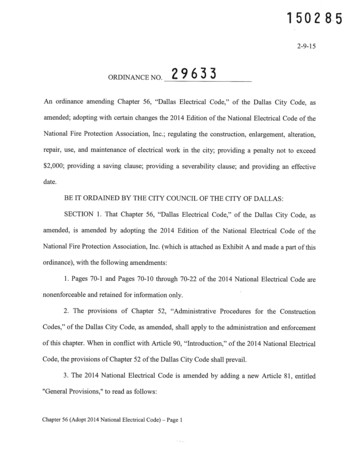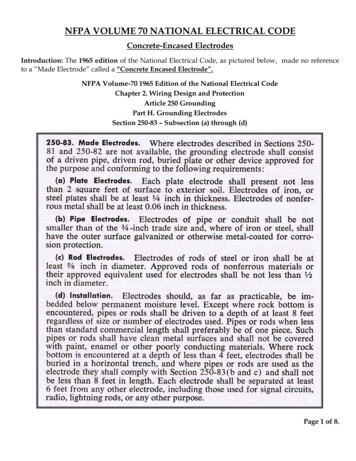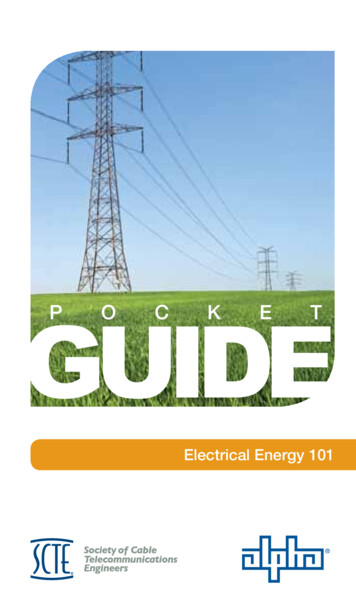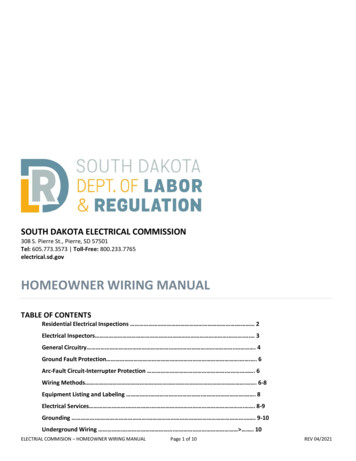
Transcription
ARTICLE90Introduction to the NationalElectrical CodeINTRODUCTION to ARTICLE 90—INTRODUCTION TO THE NATIONAL ELECTRICAL CODEMany NEC violations and misunderstandings wouldn’t occur if people doing the work simply understood Article 90. For example, manypeople see Code requirements as performance standards. In fact, the NEC requirements are bare minimums for safety. This is exactly thestance electrical inspectors, insurance companies, and courts take when making a decision regarding electrical design or installation.Article 90 opens by saying the NEC isn’t intended as a design specification or instruction manual. The National Electrical Code has onepurpose only, and that’s the “practical safeguarding of persons and property from hazards arising from the use of electricity.” It goes on toindicate that the Code isn’t intended as a design specification or instruction manual. The necessity to carefully study the NEC rules can’t beoveremphasized, and the role of textbooks such as this one is to help in that undertaking. Understanding where to find the rules in the Codethat apply to the installation is invaluable. Rules in several different articles often apply to even a simple installation.Article 90 then describes the scope and arrangement of the NEC. The balance of Article 90 provides the reader with information essential tounderstanding those items you do find in the NEC.Typically, electrical work requires you to understand the first four chapters of the Code which apply generally, plus have a working knowledge of the Chapter 9 tables. That knowledge begins with Article 90. Chapters 5, 6, and 7 make up a large portion of the NEC, but they applyto special occupancies, special equipment, or other special conditions. They build on, modify, or amend the rules in the first four chapters.Chapter 8 contains the requirements for communications systems, such as telephone systems, antenna wiring, CATV, and network-poweredbroadband systems. Communications systems aren’t subject to the general requirements of Chapters 1 through 4, or the special requirements of Chapters 5 through 7, unless there’s a specific reference in Chapter 8 to a rule in Chapters 1 through 7.90.1 Purpose of the NEC.(A) Practical Safeguarding. The purpose of the NEC is to ensure thatelectrical systems are installed in a manner that protects people andproperty by minimizing the risks associated with the use of electricity.(B) Adequacy. The Code contains requirements considered necessary for a safe electrical installation. If an electrical installation isinstalled in compliance with the NEC, it will be essentially free fromelectrical hazards. The Code is a safety standard, not a design guide.NEC requirements aren’t intended to ensure the electrical installationwill be efficient, convenient, adequate for good service, or suitable forfuture expansion. Specific items of concern, such as electrical energymanagement, maintenance, and power quality issues aren’t withinthe scope of the Code. Figure 90–1Figure 90–1Mike Holt Enterprises, Inc. www.MikeHolt.com 888.NEC.CODE (632.2633)1
Introduction to the National Electrical Code90.2Note: Hazards in electrical systems often occur because circuits areoverloaded or not properly installed in accordance with the NEC.These often occur if the initial wiring didn’t provide reasonable provisions for system changes or for the increase in the use of electricity.Author’s Comments: See the definition of “Overload” in Article 100. The NEC doesn’t require electrical systems to be designed orinstalled to accommodate future loads. However, the electrical designer, typically an electrical engineer, is concerned withnot only ensuring electrical safety (Code compliance), but alsowith ensuring the system meets the customers’ needs, bothof today and in the near future. To satisfy customers’ needs,electrical systems are often designed and installed above theminimum requirements contained in the NEC. But just remember, if you’re taking an exam, licensing exams are based onyour understanding of the minimum Code requirements.Author’s Comments: See the definition of “Overcurrent” in Article 100. The NEC is used in Chile, Ecuador, Peru, and the Philippines.It’s also the electrical code for Colombia, Costa Rica, Mexico,Panama, Puerto Rico, and Venezuela. Because of these adoptions, the NEC is available in Spanish from the National FireProtection Association, 617.770.3000, or www.NFPA.Org.90.2 Scope of the NEC.(A) What is Covered. The NEC contains requirements necessary forthe proper installation of electrical conductors, equipment, and raceways; signaling and communications conductors, equipment, andraceways; as well as optical fiber cables and raceways for the following locations: Figure 90–3(C) Intention. The Code is intended to be used by those skilled andknowledgeable in electrical theory, electrical systems, construction,and the installation and operation of electrical equipment. It isn’t adesign specification standard or instruction manual for the untrainedand unqualified.(D) Relation to International Standards. The requirements of theNEC address the fundamental safety principles contained in theInternational Electrotechnical Commission (IEC) standards, includingprotection against electric shock, adverse thermal effects, overcurrent, fault currents, and overvoltage. Figure 90–2Figure 90–3(1) Public and private premises, including buildings or structures,mobile homes, recreational vehicles, and floating buildings.(2) Yards, lots, parking lots, carnivals, and industrial substations.(3) Conductors and equipment connected to the utility supply.(4) Installations used by an electric utility, such as office buildings,warehouses, garages, machine shops, recreational buildings, andother electric utility buildings that aren’t an integral part of a utility’s generating plant, substation, or control center. Figure 90–4Figure 90–22Mike Holt’s Illustrated Guide to Understanding the 2011 National Electrical Code, Volume 1
Introduction to the National Electrical Code90.2Figure 90–4(B) What Isn’t Covered. The NEC doesn’t apply to:(1) Transportation Vehicles. Installations in cars, trucks, boats, shipsand watercraft, planes, electric trains, or underground mines.Figure 90–5(2) Mining Equipment. Installations underground in mines and selfpropelled mobile surface mining machinery and its attendant electrical trailing cables.(3) Railways. Railway power, signaling, and communications wiring.(4) Communications Utilities. The installation requirements of theNEC don’t apply to communications (telephone), Community AntennaTelevision (CATV), or network-powered broadband utility equipmentlocated in building spaces used exclusively for these purposes, or outdoors if the installation is under the exclusive control of the communications utility. Figures 90–5 and 90–6Author’s Comment: Interior wiring for communications systems, not in building spaces used exclusively for these purposes,must be installed in accordance with the following Chapter 8Articles:Figure 90–6 Telephone and Data, Article 800 CATV, Article 820 Network-Powered Broadband, Article 830(5) Electric Utilities. The NEC doesn’t apply to installations under theexclusive control of an electric utility where such installations:a. Consist of service drops or service laterals and associatedmetering. Figure 90–7b. Are on property owned or leased by the electric utility for thepurpose of generation, transformation, transmission, distribution, or metering of electric energy. Figure 90–8Mike Holt Enterprises, Inc. www.MikeHolt.com 888.NEC.CODE (632.2633)3
Introduction to the National Electrical Code90.3Figure 90–7Figure 90–9d. Are located by other written agreements either designated byor recognized by public service commissions, utility commissions, or other regulatory agencies having jurisdiction for suchinstallations; limited to installations for the purpose of communications, metering, generation, control, transformation, transmission, or distribution of electric energy where legally establishedeasements or rights-of-way can’t be obtained. These installations are limited to federal lands, Native American reservationsthrough the U.S. Department of the Interior Bureau of IndianAffairs, military bases, lands controlled by port authorities andstate agencies and departments, and lands owned by railroads.Figure 90–8Author’s Comment: Luminaires located in legally establishedeasements, or rights-of-way, such as at poles supporting transmission or distribution lines, are exempt from the NEC. However,if the electric utility provides site and public lighting on private property, then the installation must comply with the Code[90.2(A)(4)].c. Are located on legally established easements, or rights-ofway. Figure 90–94Note to 90.2(B)(4) and (5): Utilities include entities that install,operate, and maintain communications systems (telephone, CATV,Internet, satellite, or data services) or electric supply (generation,transmission, or distribution systems) and are designated or recognized by governmental law or regulation by public service/utilitycommissions. Utilities may be subject to compliance with codes andstandards covering their regulated activities as adopted under governmental law or regulation.90.3 Code Arrangement. The Code is divided into an introduction and nine chapters. Figure 90–10General Requirements. The requirements contained in Chapters 1, 2,3, and 4 apply to all installations.Author’s Comment: These first four chapters may be thoughtof as the foundation for the rest of the Code, and are the mainfocus of this textbook.Mike Holt’s Illustrated Guide to Understanding the 2011 National Electrical Code, Volume 1
Introduction to the National Electrical Code90.4 Annex C. Raceway Fill Tables for Conductors and FixtureWires of the Same Size Annex D. Examples Annex E. Types of Construction Annex F. Critical Operations Power Systems (COPS) Annex G. Supervisory Control and Data Acquisition (SCADA) Annex H. Administration and Enforcement90.4 Enforcement. The Code is intended to be suitable forenforcement by governmental bodies that exercise legal jurisdictionover electrical installations for power, lighting, signaling circuits, andcommunications systems, such as: Figure 90–11Figure 90–10Special Requirements. The requirements contained in Chapters 5, 6,and 7 apply to special occupancies, special equipment, or other special conditions. These chapters can supplement or modify the requirements in Chapters 1 through 4.Communications Systems. Chapter 8 contains the requirementsfor communications systems, such as telephone systems, antennawiring, CATV, and network-powered broadband systems. Communi cations systems aren’t subject to the general requirements ofChapters 1 through 4, or the special requirements of Chapters 5through 7, unless there’s a specific reference in Chapter 8 to a rule inChapters 1 through 7.Author’s Comment: An example of how Chapter 8 works is inthe rules for working space about equipment. The typical 3 ftworking space isn’t required in front of communications equipment, because Table 110.26(A)(1) isn’t referenced in Chapter 8.Tables. Chapter 9 consists of tables applicable as referenced in theNEC. The tables are used to calculate raceway sizing, conductor fill,the radius of raceway bends, and conductor voltage drop.Annexes. Annexes aren’t part of the Code, but are included for informational purposes. There are eight Annexes: Annex A. Product Safety Standards Annex B. Application Information for Ampacity CalculationFigure 90–11Signaling circuits which include: Article 725 Class 1, Class 2, and Class 3 Remote-Control,Signaling, and Power-Limited Circuits Article 760 Fire Alarm Systems Article 770 Optical Fiber Cables and RacewaysCommunications systems which include: Article 800 Communications Circuits (twisted-pairconductors) Article 810 Radio and Television Equipment (satel lite dishand antenna) Article 820 Community Antenna Television and RadioDistribution Systems (coaxial cable) Article 830 Network-Powered Broadband Communi cations SystemsMike Holt Enterprises, Inc. www.MikeHolt.com 888.NEC.CODE (632.2633)5
Introduction to the National Electrical Code90.5Author’s Comment: The installation requirements for signalingcircuits and communications circuits are covered in Mike Holt’sUnderstanding the National Electrical Code, Volume 2 textbook.The enforcement of the NEC is the responsibility of the authorityhaving jurisdiction (AHJ), who is responsible for interpreting requirements, approving equipment and materials, waiving Code requirements, and ensuring equipment is installed in accordance with listinginstructions.Author’s Comment: See the definition of “Authority HavingJurisdiction” in Article 100.Interpretation of the Requirements. The authority having jurisdictionis responsible for interpreting the NEC, but his or her decisions mustbe based on a specific Code requirement. If an installation is rejected,the authority having jurisdiction is legally responsible for informingthe installer of which specific NEC rule was violated.Author’s Comment: The art of getting along with the authority having jurisdiction consists of doing good work and knowingwhat the Code actually says (as opposed to what you only thinkit says). It’s also useful to know how to choose your battles whenthe inevitable disagreement does occur.Approval of Equipment and Materials. Only the authority having jurisdiction has authority to approve the installation of equipment andmaterials. Typically, the authority having jurisdiction will approve equipment listed by a product testing organization, such as UnderwritersLaboratories Inc. (UL). The NEC doesn’t require all equipment to belisted, but many state and local AHJs do. See 90.7, 110.2, 110.3, andthe definitions for “Approved,” “Identified,” “Labeled,” and “Listed” inArticle 100. Figure 90–12Author’s Comment: According to the NEC, the authority havingjurisdiction determines the approval of equipment. This meanshe or she can reject an installation of listed equipment and canapprove the use of unlisted equipment. Given our highly litigioussociety, approval of unlisted equipment is becoming increasinglydifficult to obtain.Waiver of Requirements. By special permission, the authority havingjurisdiction can waive specific requirements in the Code or permitalternative methods where it’s assured equivalent safety can beachieved and maintained.Figure 90–12Waiver of New Product Requirements. If the 2011 NEC requiresproducts that aren’t yet available at the time the Code is adopted, theauthority having jurisdiction can allow products that were acceptablein the previous Code to continue to be used.Author’s Comment: Sometimes it takes years before testinglaboratories establish product standards for new NEC requirements, and then it takes time before manufacturers can design,manufacture, and distribute these products to the marketplace.90.5 Mandatory Requirements and ExplanatoryMaterial.(A) Mandatory Requirements. In the NEC the words “shall” or “shallnot,” indicate a mandatory requirement.Author’s Comment: For the ease of reading this textbook,the word “shall” has been replaced with the word “must,” andthe words “shall not” have been replaced with “must not.”Remember that in many places, we will paraphrase the Codeinstead of providing exact quotes, to make it easier to read andunderstand.(B) Permissive Requirements. When the Code uses “shall be permitted” it means the identified actions are permitted but not required,and the authority having jurisdiction isn’t permitted to restrict aninstallation from being done in that manner. A permissive rule is oftenan exception to the general requirement.Author’s Comment: Special permission is defined in Article100 as the written consent of the authority having jurisdiction.6Mike Holt’s Illustrated Guide to Understanding the 2011 National Electrical Code, Volume 1
Introduction to the National Electrical Code90.9Author’s Comment: For ease of reading, the phrase “shall bepermitted,” as used in the Code, has been replaced in this textbook with the phrase “is permitted” or “are permitted.”(C) Explanatory Material. References to other standards or sectionsof the NEC, or information related to a Code rule, are included in theform of Informational Notes. Such notes are for information only andaren’t enforceable as a requirement of the NEC.For example, Informational Note 4 in 210.19(A)(1) recommendsthat the voltage drop of a circuit not exceed 3 percent. This isn’t arequirement; it’s just a recommendation.Author’s Comment: For convenience and ease of reading inthis textbook, I will identify Informational Notes simply as “Note.”(D) Informative Annexes. Nonmandatory information annexes contained in the back of the Code book are for information only and aren’tenforceable as a requirement of the NEC.90.6 Formal Interpretations. To promote uniformity of interpretation and application of the provisions of the NEC, formal interpretation procedures have been established and are found in the NFPARegulations Governing Committee Projects.Author’s Comment: This is rarely done because it’s a verytime-consuming process, and formal interpretations from theNFPA aren’t binding on the authority having jurisdiction.90.7 Examination of Equipment for Product Safety.Product evaluation for safety is typically performed by a testing laboratory, which publishes a list of equipment that meets a nationally recognized test standard. Products and materials that are listed,labeled, or identified by a testing laboratory are generally approved bythe authority having jurisdiction.Author’s Comment: See Article 100 for the definition of“Approved.”Figure 90–1390.9 Units of Measurement.(B) Dual Systems of Units. Both the metric and inch-pound measurement systems are shown in the NEC, with the metric unitsappearing first and the inch-pound system immediately following inparentheses.Author’s Comment: This is the standard practice in all NFPAstandards, even though the U.S. construction industry uses inchpound units of measurement. You will need to be cautious whenusing the tables in the Code because the additional units canmake the tables more complex and more difficult to read.(D) Compliance. Installing electrical systems in accordance with themetric system or the inch-pound system is considered to comply withthe Code.Author’s Comment: Since compliance with either the metric orthe inch-pound system of measurement constitutes compliancewith the NEC, this textbook uses only inch-pound units.Listed, factory-installed, internal wiring and construction of equipment need not be inspected at the time of installation, except todetect alterations or damage [300.1(B)]. Figure 90–13Mike Holt Enterprises, Inc. www.MikeHolt.com 888.NEC.CODE (632.2633)7
ARTICLE90PracticeQuestionsThese questions are based on the 2011 NationalElectrical Code. Please use the 2011 NEC Code book toanswer the following questions.5.(a) True(b) FalseArticle 90. Introduction—Practice Questions1.The NEC is .(a) intended to be a design manual(b) meant to be used as an instruction guide for untrainedpersons(c) for the practical safeguarding of persons and property(d) published by the Bureau of Standards2.Hazards often occur because of .(a) overloading of wiring systems by methods or usage not inconformity with the NEC(b) initial wiring not providing for increases in the use of electricity(c) a and b(d) none of theseThis Code covers the installation of for public andprivate premises, including buildings, structures, mobilehomes, recreational vehicles, and floating buildings.3.6.Installations of communications equipment that are underthe exclusive control of communications utilities, and locatedoutdoors or in building spaces used exclusively for such installations covered by the NEC.(a) are(b) are sometimes(c) are not(d) may be8Communications wiring such as telephone, antenna, and CATVwiring within a building shall not be required to comply withthe installation requirements of Chapters 1 through 7, exceptwhere specifically referenced in Chapter 8.(a) True(b) False7.The has the responsibility for deciding on the approvalof equipment and materials.(a) manufacturer(b) authority having jurisdiction(c) testing agency(d) none of these8.The authority having jurisdiction has the responsibility for.(a) making interpretations of rules(b) deciding upon the approval of equipment and materials(c) waiving specific requirements in the Code and permittingalternate methods and material if safety is maintained(d) all of these(a) optical fiber cables(b) electrical equipment(c) raceways(d) all of these4.Utilities may be subject to compliance with codes and standards covering their regulated activities as adopted undergovernmental law or regulation.9.When the Code uses “ ,” it means the identified actionsare allowed but not required, and they may be options or alternative methods.(a) shall(b) shall not(c) shall be permitted(d) a or bMike Holt’s Illustrated Guide to Understanding the 2011 National Electrical Code, Volume 1
Practice Questions10.Article 90Explanatory material, such as references to other standards,references to related sections of the NEC, or information relatedto a Code rule, are included in the form of Informational Notes.(a) True(b) FalseMike Holt Enterprises, Inc. www.MikeHolt.com 888.NEC.CODE (632.2633)9
Notes10Mike Holt’s Illustrated Guide to Understanding the 2011 National Electrical Code, Volume 1
6 Mike Holt’s Illustrated Guide to Understanding the 2011 National Electrical Code, Volume 1 90.5 Introduction to the National Electrical Code Waiver of New Product Requirements. If the 2011 NEC requires products that aren’t yet available at the time the Code is adopted, the authority ha










